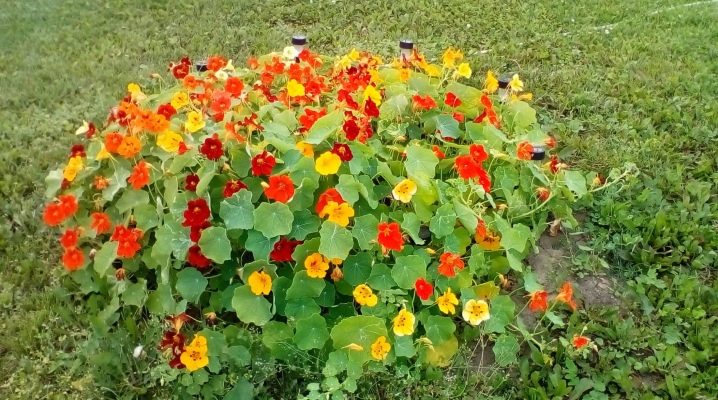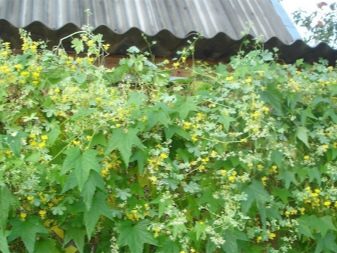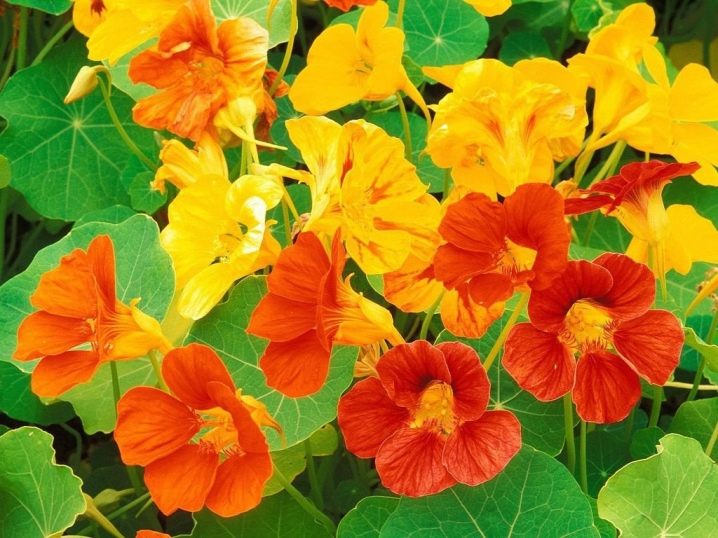Types and varieties of nasturtium

Various types and varieties of nasturtium - a beautiful flower that grows well in gardens and parks - are highly decorative, for which they are valued in the field of landscape design. The plant is unpretentious, but thermophilic, abundantly forms buds, easily propagates by seeds collected at the end of budding. Having studied nasturtium curly and large, undersized and terry, ampelnaya and "Maiden beauty", as well as other types and varieties of flowers, you can learn more about the variety of its palette, other features.


Features of foreign nasturtium
Canary liana, or foreign nasturtium (Canary watercress), got its first name from the place of discovery. But the natural habitat of this species turned out to be much wider. Curly nasturtium, in addition to the Canary Islands, can be seen in western South America, Peru and Ecuador. This thermophilic flower looks very impressive in a flower bed and in a flower pot, but has not become widespread in Russia as a garden culture.
Variety "Canary" is a perennial nasturtium, grown in a one-year cycle in temperate climatic zones. Low winter hardiness, only up to -6 degrees, makes it impossible to preserve plantings in the open air. At the same time, foreign nasturtium is successfully grown year-round in greenhouses, greenhouses.


"Canary" has a well-developed root system and a high growth rate. When grown without support, it forms a continuous cover carpet with stems up to 3.5 m long. In the presence of a trellis, it quickly wraps around it with its shoots. Plants are distinguished by their ability to long-term continuous flowering, from June to the very frost, but sometimes the seeds do not have time to ripen in the time allotted to them.
The name of the variety is fully justified by its bright colors. Bright yellow tones, "disheveled" shape of the petals - all this makes the corolla look like an easily fluttering bird. A red spot may be present at the base of each of the 5 petals. This most popular variety of the Canary liana is grown on trellises and as a plant that weaves around gazebos.
Foreign nasturtium is an exotic, delicate plant with climbing stems up to 2.5 m long. In nature, it coexists with other plants, using them as a natural support. Stems are highly branching, glabrous, covered with rounded green leaves on purple-colored petioles.


Description of large nasturtium and its variety
Known botanically as Tropaeolum majus, nasturtium large is an annual herbaceous vine with creeping, highly branched stems. On a support, the plant reaches a height of 2.5 m, without it it gains a height of 20-70 cm. With excessive moisture, the plant is prone to intensive development of shoots to the detriment of flowering. The color range of this type of nasturtium is quite varied.


The petals can be painted in the following colors:
- pink;
- Red;
- Orange;
- yellow.
The leaves of nasturtium are large, rather large, up to 80 mm in diameter, rounded, lighter above than below. On the surface of the plates, there may be a golden or purple tone, stripes, spots and stains. This gives them a special decorative effect. The flowers are also quite large, on average 50-70 mm in diameter, can be double and simple, attached to elongated stems.

Among the popular plant varieties are nasturtiums with the following names.
- "Salmon". The petals of the plant have a characteristic orange-pink hue.

- "King Theodore"... Luxurious variety with bright red flowers. The color is evenly distributed. The variety is quite unpretentious, it is considered one of the most popular.

- "Ladybug". Unusually colored nasturtium is large with yellow or apricot petals and red spots at the base.

- Salmon baby. The flower petals have a semi-double structure, colored in the background salmon tone with a yellow base of the petals.

- Peach Melba. Refined, brightly colored flowers with peach and cream petals covered with wine-red spots.

The variety of shades is exactly what summer residents love so much for large nasturtium. The plant is able to transform a flower bed or flower garden, providing it with decorative effect throughout the day.
Other popular varieties
Nasturtium is quite popular as a horticultural crop, but not all of the 90 species are suitable for planting in temperate climates. They are placed in a mixture or separately, harmoniously combining ampelous and bush plants, combining yellow, orange, red buds in one composition. Rare of them are May in terms of flowering, others begin to bloom in June.
The varietal variety is also impressive. Among ampel and pot varieties, special attention deserves "Alaska", which is a mixture of plants of different colors. Stunted, including "King Theodore" and "Maiden Beauty", are used to revitalize flower beds and flower beds. Unusual terry - "Cherry Rose", "Terry Tale" - are appreciated for their special decorative effect, they are good both in mixborders and in individual plantings. Curly nasturtiums look great on trellises.


Cultural
Annual nasturtium is a herbaceous vine, prone to abundant self-seeding, rather easy to grow. This is what attracts the attention of summer residents in it. Cultural nasturtium is distinguished by its varietal diversity. Plants can be:
- dwarf, up to 20 cm tall;
- creeping, with shoots up to 40 cm long;
- compact bush, up to 0.5 m.
This species blooms in June, retains the ability to bud until frost. The color of the petals is not too varied. Presented only in yellow and orange tones. The leaves are unusual, thyroid, colored green or purple.

Cultivated nasturtium is a hybrid of large and thyroid varieties... The flowers have a pleasant aroma. All plant varieties are very decorative. But the following are considered the most accessible and decorative.
- Moonlight... The name of this variety is translated as "moonlight". Plants are quite tall, up to 4 m, colored red with yellow longitudinal stripes on the petals.

- Golden Globe... A popular bush variety that has a spherical shape. It grows up to 25 cm, flower petals are evenly colored yellow-orange.

- Gleming Mahagani. Nasturtium with shoots up to 40 cm long. Flowers of a double structure are colored red.

These varieties look good in a flower garden together or in separate plantings. Climbing varieties can be placed on supports or grown as a ground cover species.
Small
Miniature nasturtiums with a lemon-yellow color of large flowers and noticeable red spots at the base can become a real decoration of a flower bed. The stems of the small variety do not exceed 35 cm in length. The scourges cover the ground with a solid carpet, the leaves are medium-sized, round-thyroid-shaped.
The plant is considered the most unpretentious among nasturtiums. Requires a minimum of attention during the cultivation process. Small nasturtium seeds have time to fully mature over the summer and autumn. Plants are suitable for cultivation in pots and outdoors.
The varietal diversity of small nasturtium is not too great. The most popular planting options are:
- "Black corduroy" with maroon, almost black color of petals;

- "Cherry rose" with a terry structure and wine-colored rims;

- mixture "Maiden beauty" with red, peach, yellow and orange corollas is also very much in demand by gardeners.

Shield-bearing
Traditional for South America, widespread in the wild. As a perennial, it can be grown even in temperate continental climates. Curly shoots reach 4 meters in height, quickly entwine walls and other vertical supports. In Russia, nasturtium is grown as an annual plant, with planting in the spring, since the fleshy root shoots do not tolerate winter temperatures.
When grown without supports, the plant is used as a cover. Its dark green leaves effectively set off large yellow-orange flowers with carmine-cherry blossoms on the petals. The rim diameter can be up to 60 mm.

The magnificence of the shield-bearing nasturtium is striking. It is she who has the largest variety of shades. Popular varieties include:
- red-orange "Lucifer" with a yellow core;
- "Azure" with pale blue petals;
- "Beautiful" with an unusual shape of a strongly dissected rim;
- "Multi-leaved" with garlands of golden flowers, looks good in ampelous design.
Even these varieties, considered the most unpretentious, feel best in the southern regions of Russia. In temperate climates, they have to be sown annually, since the exotic delicate plant cannot be adapted to the frosty winter conditions.








































































































The comment was sent successfully.